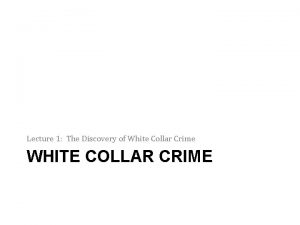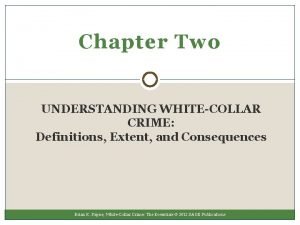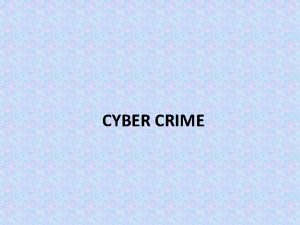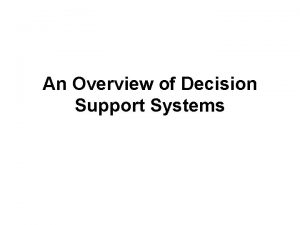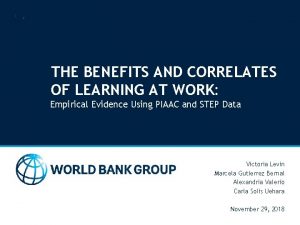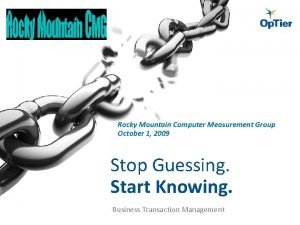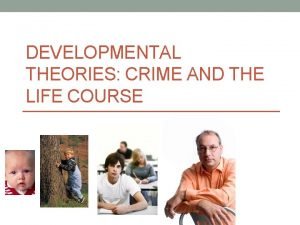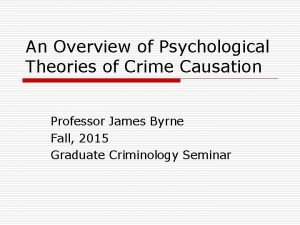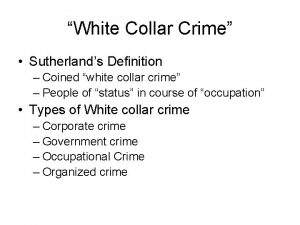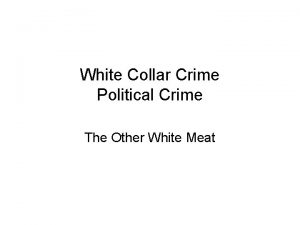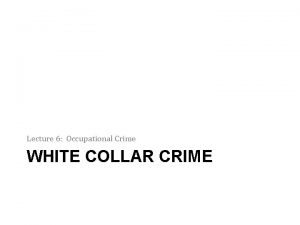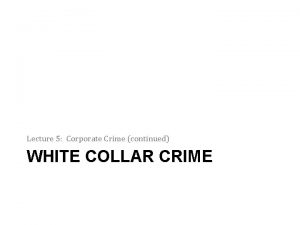Lecture 10 Explaining White Collar Crime Theories Accounts












- Slides: 12

Lecture 10: Explaining White Collar Crime – Theories & Accounts WHITE COLLAR CRIME

Goals • To understand what makes individuals or organizations commit white collar crime. • To understand why the incidence of white collar crimes varies among occupations and industries. • To understand the origins of white collar crime laws or regulations.

Are White Collar Criminals Made or Born? Made Psychological Explanation Born Biogenetic Explanation Somewhere in Between Sociogenic Explanation

Biogenetic Explanation: Core Belief • Inherent differences from other people, even down to appearance. o Factors ranging from body type to brain chemistry contribute to white collar crime

Psychological Explanation: Core Belief • Personality traits, mental processes, the enduring effects of early childhood traumas, and the like contribute to WCC behavior.

Sociogenic Explanation: Core Beliefs • Matter of criminality can be explained in terms of alleged differences in criminal propensities among members of different social classes or groups.

Organizational Criminal Liability • Can an organization be criminally liable?

Yes No Corporations “take on lives of A corporation cannot act. their own. ” Corporations socialize their executives to respond with criminal actions when profits are threatened. Corporations are autonomous and can therefore be held responsible. Punishing only individuals would not deter corporate crime. The entire organization is seldom involved in corporate crime, and the majority of personnel do not participate.

Factors Contributing To Organizational Criminality • • • Size of the corporation Financial performance Emphasis on profit Diffusion of responsibility Promotion of loyalty and deference to the corporation

Organizational Criminal Liability: Theories • Ultra Vires Doctrine: corporate powers are limited to what is authorized by the corporate charter; therefore, the corporation cannot be held responsible for executive actions that are not so authorized. • Imputation Theory: corporation is liable for the intent and acts of its employees (generally excludes acts intended for sole benefit of the employee) and subsidiaries.

The Imputation Theory is also known as the Respondeat Superior Doctrine: • Ascribes corporate criminal responsibility when a corporate agent: (1) has committed a crime, (2) is acting within the scope of his/her authority, and (3) has the intent to benefit the corporation. • Prosecutor does not need to identify the specific individuals responsible for the illegal act and need not demonstrate any actual benefit for the corporation.

Organizational Criminality: Rationalizations • • Laws/Regulations are incomprehensible Laws/Regulations are too complex Laws/Regulations are unnecessary/unjustified Laws/Regulations interfere w/ free enterprise “Everyone is doing it” No real harm Economic necessity
 White collar crime meaning
White collar crime meaning White collar crime meaning
White collar crime meaning White collar definition
White collar definition Blackening and tattooing
Blackening and tattooing Kejahatan kerah biru (blue collar crime)
Kejahatan kerah biru (blue collar crime) Gdss
Gdss Principles of information systems
Principles of information systems White and blue collar worker
White and blue collar worker Computer measurement group
Computer measurement group Theories of human development
Theories of human development Psychological theories crime causation
Psychological theories crime causation Sociological perspective of crime
Sociological perspective of crime Modern biological theories of crime
Modern biological theories of crime

